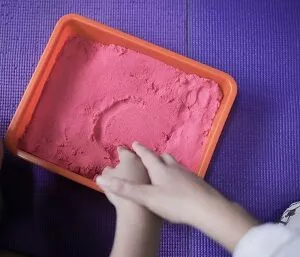
Written by
Meghna Elizabath Zachariah, M.Sc., B.Ed (LD)
Special Educator
In a traditional classroom, a teacher enters the class, greets the students, writes words on the board, asks students to read and then asks students to copy the words onto their notebooks. This process is repeated for every class. Over here, learning mainly relies on vision and hearing only. This fixed structure of teaching method makes learning a boring and burdensome process.
Now, if the teacher comes to the classroom with colourful pictures and different textured materials and incorporates songs and movement in the teaching-learning process, everything becomes much more fun and interesting for the learners and the teachers. Giving such activities stimulates and engages multiple senses of a child. This is called multisensory teaching.
Let us see more about this.
Multisensory Learning Style
Multisensory learning style uses multiple senses to gather and process information. When information is received through multiple senses children learn better and also with more interest.
Visual Reasoning And Learning
A visual learner can be supported by presenting information visually. The use of posters, pictures, concept maps or graphic organizers etc. can help children learn through visual modality.
Auditory Techniques
Auditory techniques present content in auditory form. Rhymes, music, songs can be used to teach children who prefer auditory modality for learning.
Tactile Teaching Methods
The method of using the sense of touch is called tactile teaching method. Methods like sand writing, using manipulatives like beads to teach counting are some examples.
Kinesthetic Method
Kinesthetic method includes the use of movement to teach a particular skill. For example, while teaching counting a child can be asked to jump ‘1’ time or ‘3’ times. Also while teaching letter formation of ‘A’, the outline can be drawn on the floor and the child can be asked to walk along the outline.
For a better understanding of the multisensory approach to teaching, here is an example. To teach the sound of alphabet ‘a’ through the multisensory approach we can first introduce the sound of the alphabet through a simple story(auditory technique), then the child can be made to form the letter ‘a’ by writing the letter in the air using his/her hand(kinesthetic technique), then pictures of items starting with the sound of ‘a’ can be shown and said at the same time(visual and auditory technique) and letters can be written on sand while saying the sound(tactile and auditory technique) after which a rhyme can be sung along with actions(Auditory and kinesthetic technique).
Multisensory Learning Activities
Multisensory learning activities engage multiple senses. By incorporating multisensory activities into learning, children will learn and also retain what is learnt more effectively. Here are a few multisensory activities:-
Read it.. Build it.. Write it!
This hands-on activity is a great way to teach children how to read, spell and write words. Sight words can be taught effectively using this method. The word to be taught should be read out first by the teacher and then the student should be made to repeat it. Then the child should be made to build the word using letter cards, magnetic letters or clay. After this, the child should be made to write the word.

Writing in sand/shaving cream
Sand writing or writing in shaving cream can be used for multisensory learning. For instance, while teaching letter sounds you can say the sound of the letter and ask the child to repeat it, then the letter can be placed above the sand tray and the child can be asked to form the letter on the sand/shaving cream while saying the sound.

Air writing
Air writing is a simple way of learning spelling. The word is read from a flash card and then underlined using fingers. Then each letter is written in the air using the fingers while saying the name of each letter and then the word. This is repeated 3-4 times
Arm tapping
Kinesthetic and tactile learners will enjoy this method. It involves tapping arms while saying the letters of a word. Sight words are taught in this manner. For example, the word “said” can be taught by segmenting the sounds as “s”-“ai”- d”. While saying the sound use the index and middle finger together to tap the sound. For instance, tap on the shoulder saying ‘s’, on the elbow saying ‘ai’, and on the wrist saying ‘d’.
Blending boards
Blending boards are an effective tool to teach students the foundations of blending different letter sounds. Letter cards are placed on the board and then blended(visual and auditory). Through this children can learn to manipulate and blend different sounds thereby strengthening the skill of blending different sounds. This is one of the important skills required to decode words.
Conclusion
Incorporating multisensory approaches and techniques helps children to become more active learners. It offers a hands-on experience to children which makes them motivated to learn new skills and retain what is learnt. Presenting content through multiple modalities also caters to different types of learners making content accessible to all.
Read More: Multisensory Learning

